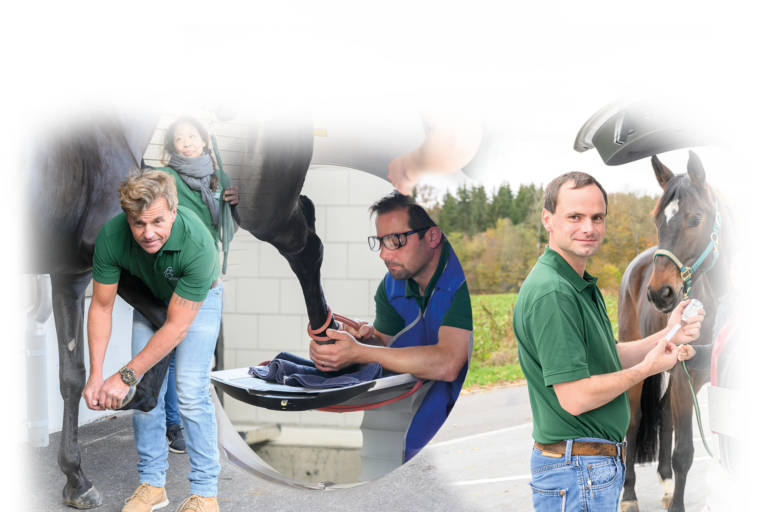
The small town of Niederlenz in the heart of the canton Aargau is around half an hour’s drive from Zürich and is home to one of Europe’s most advanced equine hospitals. Founded in 1981 as Pferdeklinik Neugraben AG, even then the practice enjoyed an outstanding reputation. In late 2019, the hospital moved from its idyllic but somewhat confined premises in the centre of Nieder-
lenz to a newly built and markedly more spacious facility at the town’s outskirts. As a true logistical feat, the move was successful thanks to the efforts of the entire team – as Dr Christian Czech, one of the hospital’s senior vets, emphasises. Dr Czech is accompanied by two other partners: Markus Schmidt, who joined the clinic in 2008, and Dr Theo Tschanz, whose time at Niederlenz goes back to 1988. The team also comprises five vets, an equine dentist, eight veterinary assistants, plus four administrative staff, a specialist staff member responsible for the pharmacy and goods management, a site caretaker, and two stable assistants from Eritrea. A truly international team.
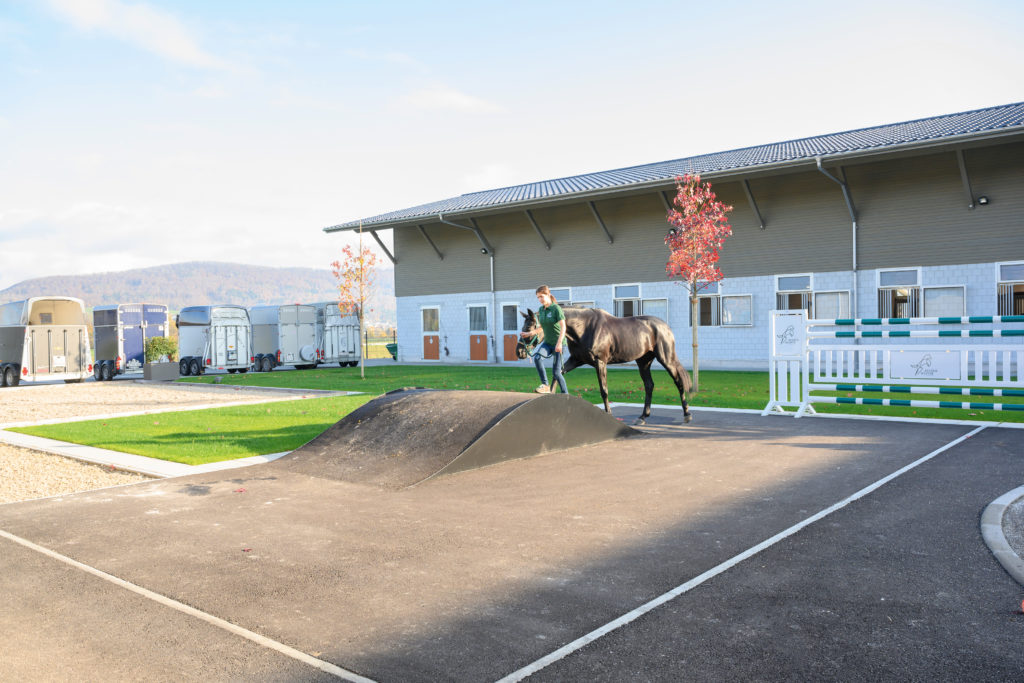

Born in Lower Saxony in Germany, Dr Christian Czech has worked at the Niederlenz practice for 15 years and became a partner
in 2010. After completing his studies, he wrote his dissertation in the USA before following the advice of Dr Matthias Baumann – German equine specialist veterinarian and team eventing gold-medallist at the Seoul Olympics – and made the move to Niederlenz. The rest, as they say, is history.
Dr Christian Czech has two children with his wife, Dr Dory Czech, who is also a vet at the Pferdeklinik Niederlenz. When not with his family, caring for patients or devoting himself to continuous medical education, he tends to create big plans. Building a new hospital was one of those plans, and indeed
a very impressive example.
“Not only is all staff at Niederlenz encouraged to
take advanced training, they are required to do so.”
“We always strive to achieve the highest standards of medical quality. Our passion for our profession and empathy for horse and rider go hand-in-hand.”
The imposing yet ultra-modern main building, riding hall and stables are set on premises spanning almost 7,000 square metres. At the heart of the site is a unique covered trotting area, including two lunging rings with hard and soft floors as well as an undulating, slip-proof surface to assess horses’ coordination skills and back mobility. All of these facilities have been carefully considered into the smallest detail.
Our services for you:
Two stalls are located directly adjacent to the operating theatre – one pre-op stall
and one recovery stall. Staff prepares horses before they reach the operating theatre to ensure they are as sterile as possible upon arrival, thereby reducing the risk of complications due to infection.
The stables, outdoor areas and separate recovery and intensive-care stalls are permanently video-monitored, allowing all vets to access a live stream using their smartphones at all times. This ensures that patients are closely monitored around the clock.
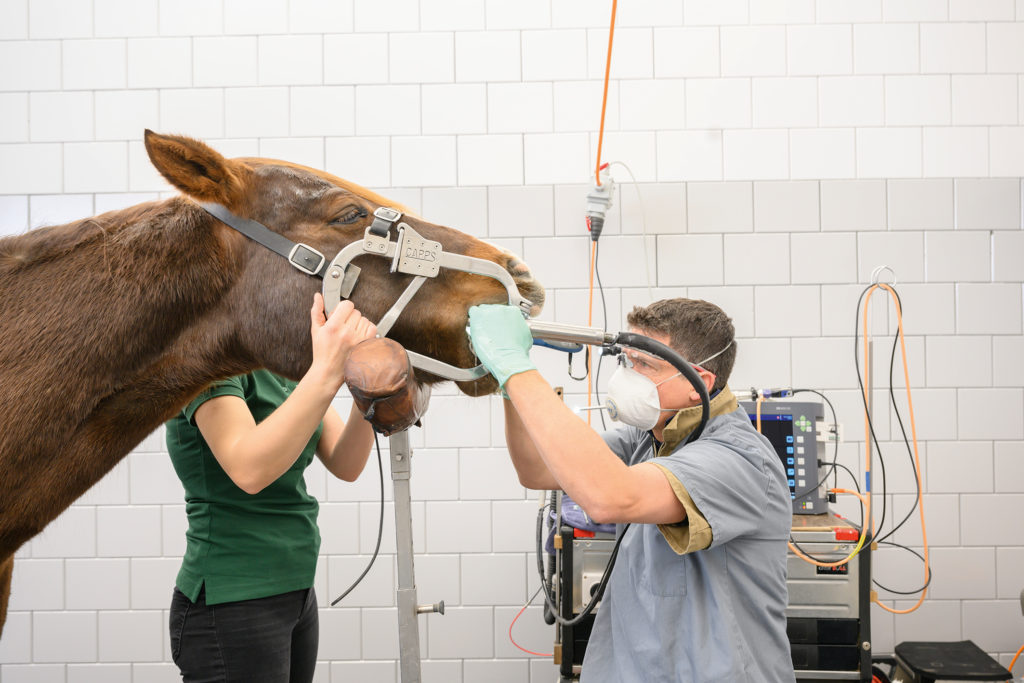

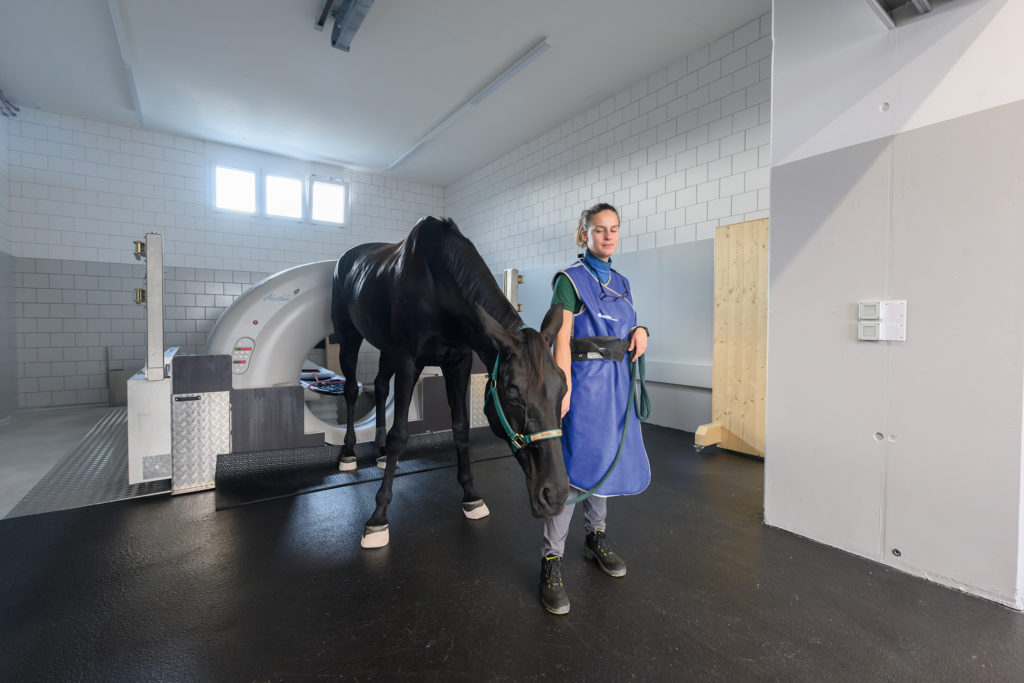

Modern technology plays a crucial role throughout this equine hospital in northern Switzerland. Large flatscreen monitors are omnipresent, reflecting the importance and complexity of the diagnostic imaging facilities at the Pferdeklinik Niederlenz – which are state-of-the-art. Even at first glance, it is clear this is not an ordinary equine hospital. Consequently, the staff in Niederlenz is not only encouraged to take continuous medical training, “it is a requirement”, emphasise the partners Czech, Tschanz and Schmidt. The trio, of course, sets an example in this regard.
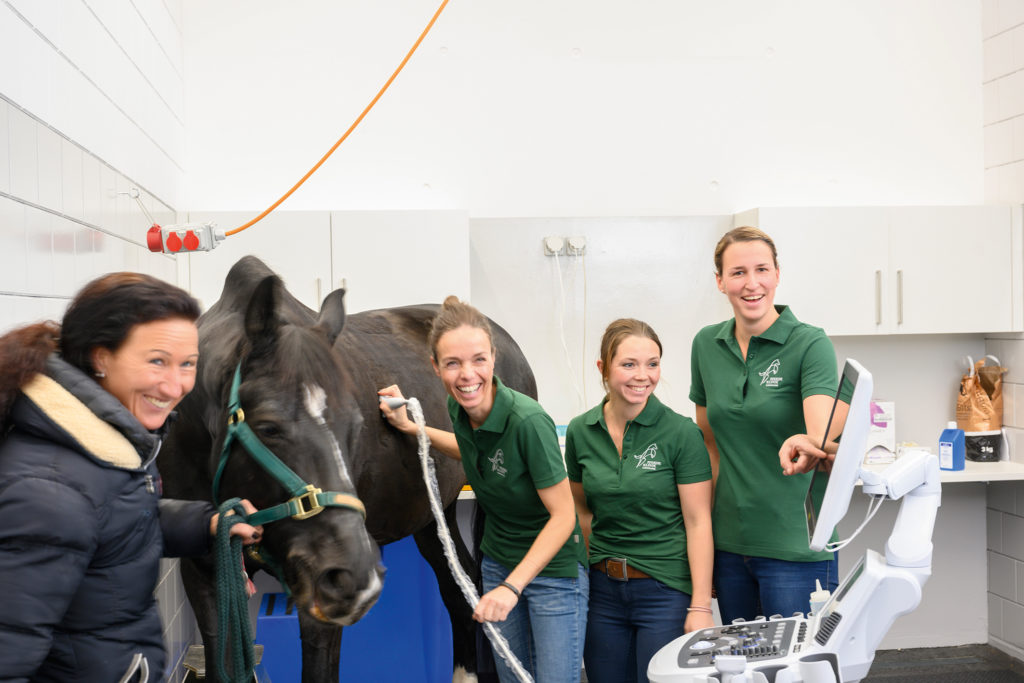

While the Pferdeklinik Niederlenz AG also provides a mobile vet service with a small fleet of fully equipped vehicles – each equipped with ultrasound devices, endoscopes and mobile X-ray devices – the clinic is, first and foremost, a referral hospital. Its patients are by no means limited to the local area. As FEI veterinarian, Dr Czech supervises prestigious competitions, treats numerous championship horses, and also manages their health to already prevent issues. As a result, the hospital’s vets do not only work in Switzerland but also travel regularly to Germany, Austria and France to see patients. After studying in Bern, Dr Tschanz earned his doctorate by exploring potential enhancements to scintigraphic imaging technologies under the guidance of Prof. Ueltschi. Since then, he became a well-known and highly respected equine vet in the French-speaking part of Switzerland, and not only for racehorses and polo ponies. “My personal favourite horses are the charismatic, athletic ones,” says Christian Czech. That said, Niederlenz is by no means reserved for elite-level horses trained for Olympic competition; the team displays the same care and dedication whether their patient is a racehorse, a Western-trained horse, a poly pony, a leisure pony, or a donkey. The hospital’s philosophy is: “We always strive to achieve the highest standards of medical care which is accompanied with our passion for our profession and the empathy for horse and rider going hand-in-hand. Taking this as our basis, we aim to find the best solution for every horse in each individual case.” In Niederlenz, this philosophy is more than mere theory: every member of the team visibly embodies its guiding spirit.
1. Veterinarians
9
Specialists with internationally recognised (European / US) qualifications
–
Specialists with national qualifications
2
Veterinarians, assistant veterinarians
4
2. Veterinary technicians and horse grooms with additional medical training
9
Trainees
+ 6
3. Horse grooms
2
4. Administrative staff
5
5. Other staff
1
6. Box stalls
25
Normal equine box stalls
23
Padded box stalls
–
Box stalls for mares with foals
–
Isolation box stalls
2
7. Examination / treatment rooms
6
8. Operating rooms
3
For procedures on standing horses
2
For procedures on lying horses
1
9. Paddocks
–
10. Pastures
–
11. Horse walker
–
12. Other
–
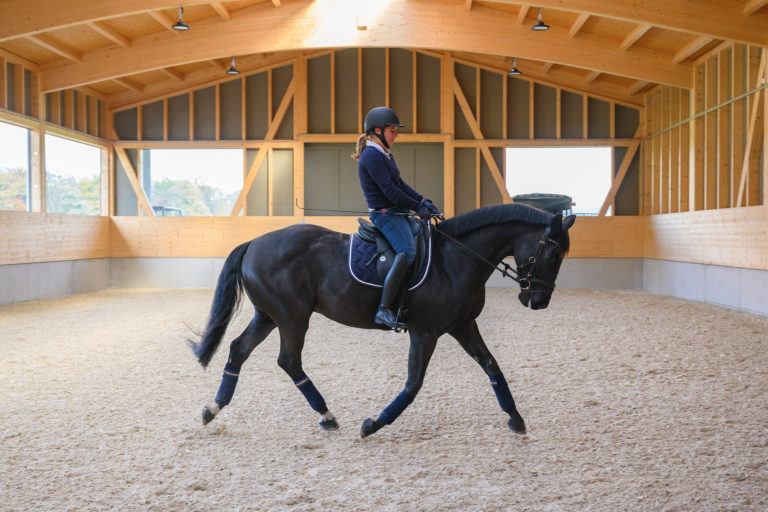

9
internationally recognised veterinary surgeons in different areas of expertise take care of the four-legged patients
Weighting of the specialist areas for Equine Hospital Niederlenz AG
Soft tissue surgery
Weighting: 81 to 100%
Equine soft tissue surgery primarily relates to abdominal/colic surgery and operations in the region of the urinary system, the sexual organs, and the upper and lower respiratory tracts, as well as operations on the skin.
Orthopaedic surgery
Weighting: 81 to 100%
Orthopaedic surgery is surgery on the musculoskeletal system of a horse. This includes operations relating to the bone skeleton, such as fracture fixation. It also includes endoscopic and arthroscopic procedures on joints, bursae and synovial sheaths, as well as operations on ligaments and tendons.
Orthopaedic diagnostics & therapy
Weighting: 81 to 100%
The field of orthopaedic diagnostics & therapy deals with musculoskeletal diseases and disorders, particularly relating to lameness.
Dentistry
Weighting: 81 to 100%
Dentistry involves prophylactic examinations of teeth and the oral cavity as well as the diagnosis and treatment of dental diseases and associated diseases of the paranasal system.
Internal medicine
Weighting: 51 to 80%
The specialist field of internal medicine subsumes a number of subareas and deals with the diagnosis and treatment of diseases of the internal organs. These include diseases of the gastrointestinal tract, the respiratory system, the urinary system, the blood and blood-forming organs, the muscles, the nervous system and the skin, plus hormonal and metabolic disorders and all infectious diseases.
Cardiology
Weighting: 21 to 50%
Cardiology is a separate specialty within the field of internal medicine and concerns the diagnosis and treatment of cardiovascular diseases and disorders, including cardiac arrhythmias, valve disorders, myocardial and pericardial disease and congenital cardiac malformations.
Intensive care and emergency medicine
Weighting: 51 to 80%
Intensive care and emergency medicine involves administering first aid in serious emergencies as well as providing care to and monitoring horses and foals with life-threatening illnesses. This also includes post-operative care to patients in need of intensive care.
Sports medicine
Weighting: 21 to 50%
Sports medicine entails the diagnosis and treatment of performance-related diseases and illnesses in sport horses and workhorses. Special dynamic examination methods are often used in this field, including performance tests, endoscopy during exercise, kinetic and kinematic gait analysis, and saddle pressure measurements.
Rehabilitation medicine
Weighting: 21 to 50%
The field of rehabilitation medicine is concentrated on recovery following surgical procedures, medical movement therapy to treat back pain and abnormal posture, and improving the quality of life of animals suffering from debilitating diseases such as arthritis or neurological impairments.
Ophthalmology
Weighting: 51 to 80%
Ophthalmology deals with diseases and functional disorders of the eyes, their adnexa, and the optic nerve up to the visual cortex in the brain – the visual processing centre. Ophthalmologists also perform surgical procedures on eyes.
Reproduction medicine
Weighting: 21 to 50%
Reproductive medicine involves the diagnosis and treatment of diseases relating to the sexual organs and the udders as well as breeding suitability tests, assisted reproduction, pregnancy-related diagnostics and obstetrics.
Anaesthesia
Weighting: 81 to 100%
The specialist field of anaesthesia is concerned with professionally sedating and anaesthetising horses and sparing them unnecessary pain. Thanks to state-of-the-art methods and gentle techniques, it is now possible to perform complicated surgical procedures and life-saving emergency operations on seriously injured or sick horses and to transport them safely.
Diagnostic imaging
Weighting: 81 to 100%
Diagnostic imaging is the process of examining a horse using digital X-ray technology, ultrasound, computed tomography (CT), magnetic resonant imaging (MRI) and scintigraphy. Nowadays, many of these diagnostic techniques do not require general anaesthesia and can be performed on a standing horse.
Field service
Weighting: 81 to 100%
Veterinarians in field service provide emergency and primary healthcare to horses where they live. Modern field service providers possess a variety of mobile tools and equipment, allowing them to perform some in-depth examinations and treatments on-site.
Transport services
Weighting: 81 to 100%
Professional large-animal transport services safely transport seriously injured or diseased horses – such as horses with severe colic – to an equine hospital. Horses with complex fractures or severe neurological conditions can also be transported safely and with due care, either using a harness to alleviate the load on the fracture or by lying the animal on a mat. The same applies for transporting recumbent horses. Some largeanimal transport services also specialise in recovering horses from extreme situations, such as rescuing horses who have fallen using a winch, crane or helicopter.
Weighting of the specialist areas: range of services offered compared with the maximum service spectrum in the corresponding area.
Equine Hospital Niederlenz AG
Hummelweg 10, 5702 Niederlenz

